Investment Thesis
Apartment REITs have a simple yet resilient business model that continually generates stable cash flow. However, the pandemic has jeopardized the outlook of the multifamily subsector as the narrative of an urban exodus surfaced in major news channels and publications. While coronavirus-induced trends such as work-from-home policies may have contributed to a slight outflow of individuals from major cities such as San Francisco and New York, other urban cities are not experiencing the mass exodus that mainstream media has claimed. The media has mistaken temporary headwinds for permanent change. Coastal megacities have gone through black swan events before and they will recover again like they have done so in the past. As it stands, stocks of coastal apartment REITs remain at least 30% down from their previous highs and have been consolidating in a range for months, a great buying opportunity for patient investors.
Bears Say: “Urban Exodus, Work-From-Home Policies, and Home Ownership Appeal”
The coronavirus outbreak and government mandates of social distancing measures since March have spurred the idea of an urban exodus where residents flee from major cities to suburban or rural areas. Over the last few years, the trend of densification has squeezed more and more people in the same amount of space. However, social distancing measures have forced a reversal in this trend as space becomes a crucial component of daily business operations. Office desks are being spaced out. Commercial airplanes are limiting passenger load. Restaurants and theaters are blocking seats. However, the pandemic had not only changed business practices but also shifted consumer behaviors – one of which includes migration out of megacities.
The outflow of businesses and individuals out of megacities will undoubtedly hurt businesses that have, for decades, built solid footing in these megacities. That includes one of the most illiquid and inflexible types of businesses: apartment REITs. However, concerns about the coronavirus is not the only reason why people want to move out of major cities. According to a survey of 782 New York City adults earning at least $100,000, only 34% of respondents said that coronavirus would be a reason for them to relocate. Factors such as cost of living and crime were the most concerning for New Yorkers.
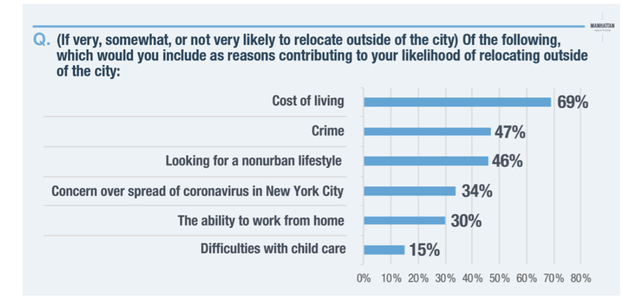
(Source: Manhattan Institute)
Another reason why people want to move out of major cities is due to work-from-home policies enacted by companies. Twitter (TWTR), for example, allowed staff to work from home forever. That said, TWTR employees do not have to rent expensive apartments near their headquarters in San Francisco when instead, they could be working remotely from the comfort of cheaper apartments in the Midwest.
In addition, some schools are still closed and thus, only offer remote learning at the moment. This means that college students do not have to live near their campuses, which is why we’re seeing the largest share of young adults living with parents since the Great Financial Crisis. How about international students? The combination of travel restrictions and the loss of value associated with online learning has also driven more international students out of the United States. Keep in mind, international students are typically affluent and prefer renting apartments than owning single-family homes.
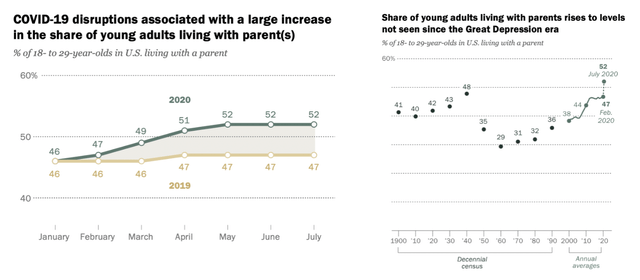
(Source: Pew Research)
Single-family homes have also become a more attractive option compared to multi-family homes during the pandemic for two reasons. First, single-family homes offer more space than cramped up apartments in central business districts. Space may be one of, if not, the most important feature for buyers or renters in the market as they know that they will be spending the majority of their time at home these days. Secondly, the pandemic has forced the Fed to cut interest rates to near zero, thus substantially reducing mortgage rates and the cost of homeownership.
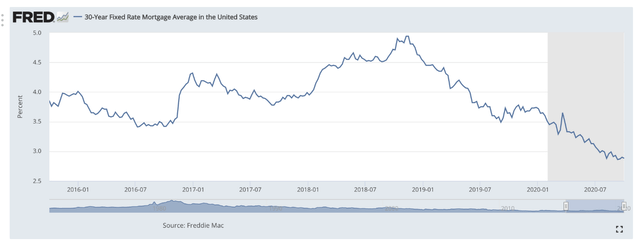
(Source: FRED)
Given that affordable housing is mostly found in suburban and rural areas, the majority of home purchases are done outside of major cities. As a result, new home sales have surged through the roof in recent months.

(Source: Trading Economics)
The virus-induced trends of urban exodus, work-from-home policies, and lower interest rates have presumably caused renters in coastal apartments to migrate to the suburban areas or even take advantage of cheap housing. Other factors such as political unrest, homelessness crisis, and frequent wildfires may also reduce the attractiveness of coastal cities. While apartment landlords in these regions are unquestionably facing major headwinds, we do not know for sure whether these trends will be permanent or not.
Bulls Say: “Those Are Temporary, Megacities Will Recover”
Bulls may say that the trends described above are largely overblown and they are temporary in nature. There are several factors why this may be true. Firstly, the notion that offices are dead and that we’re all going to work remotely forever is absurd. Instead, a hybrid working environment where employees split time between the office and at home is a more sustainable solution. The office is here to stay and executives understand the value that comes from the traditional office environment. I recently wrote an article on office REIT Boston Properties (BXP) and the company reported that predominantly, technology and healthcare companies, including Microsoft (MSFT), continued to expand their office footprint amid the pandemic – BXP operates in major metropolitan areas, including urban coastal cities. Such investments indicate that employers expect their employees to return to the office eventually.
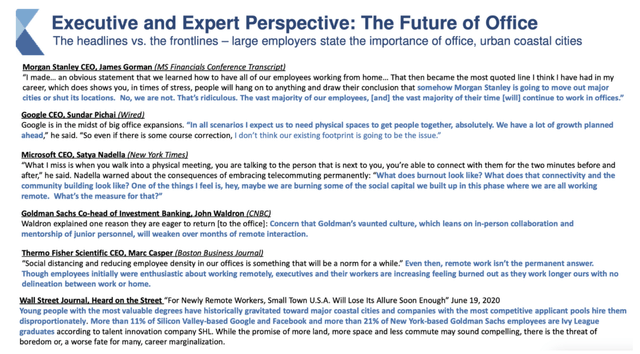
(Source: BXP Q2 2020 Investor Materials)
Secondly, while there were headlines of an urban exodus, there has not been much data to support that thesis. In fact, the opposite may be true. According to Apartment List, searches for higher-density cities were incrementally higher in 2020 Q2 than in 2020 Q1. Searches for lower-density cities, on the other hand, dropped by 3% quarter-over-quarter.
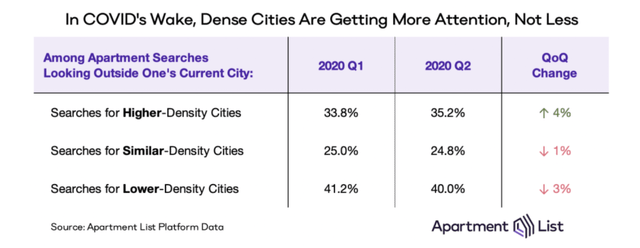
(Source: Apartment List)
In addition, suburban residents, not urban dwellers, drove new search interest. As shown below, the share of searches from a secondary city to principal cities increased by 11% quarter-over-quarter. Although searches do not necessarily mean actual move-ins or move-outs, it does point the general direction where people are interested in moving to – and that is to urban cities.
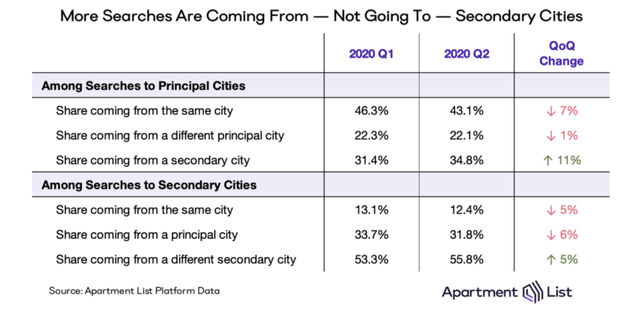
(Source: Apartment List)
As emphasized earlier, searches do not mean moves. This is rightfully so as data from Bloomberg shows that Americans moved less during the pandemic. For example, California and New York experienced -35% and -38% drops in moves compared to last year, respectively. However, this was data from March 11 to June 30, when shelter-in-place orders sent the nation into a lockdown for about a month before easing restrictions. In June alone, interest in moving was 14% higher compared to the same month last year.
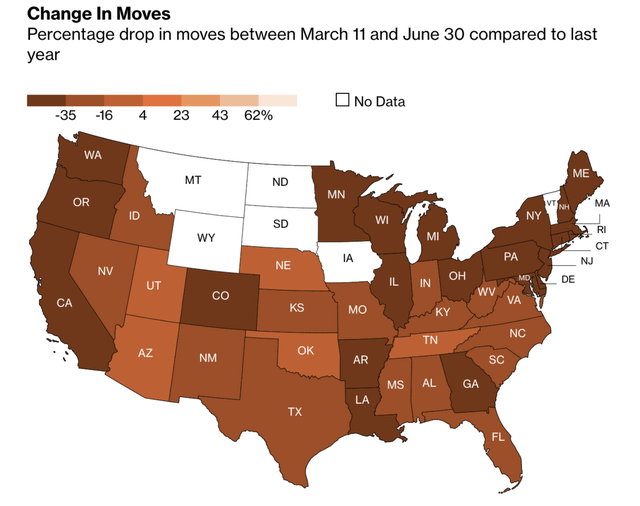
(Source: Bloomberg)
It is important to note that while Americans moved less during the second quarter, there were several specific cities that experienced larger-than-normal net outflows as compared to the same period last year. According to local moving company Hire A Helper, New York and San Francisco had the biggest net move-outs since the pandemic, at about 80% each. This means that there are 80% more move-outs than move-ins. However, there were only 279 moves in New York and 69 moves in San Francisco since the pandemic, not a significant number in my opinion. Note: this data consists of only Hire A Helper’s client base.
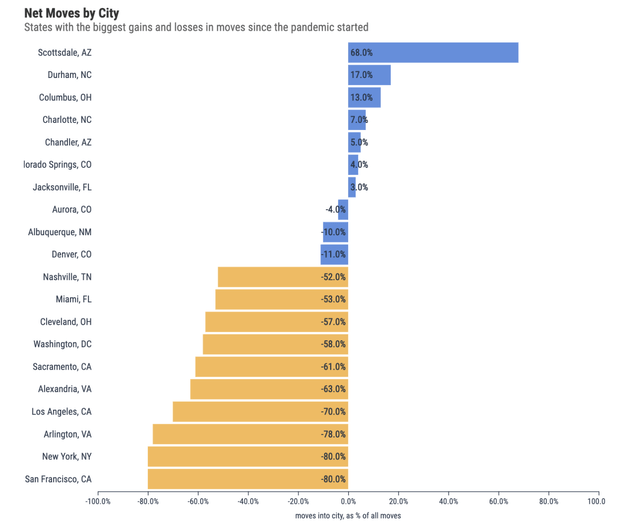
(Source: Hire A Helper)
New York and San Francisco clearly stood out from the rest. Zillow (Z) also reported that these two cities were the most negatively impacted cities, while other urban cities experienced minor struggles. The question is: for those that moved out of New York and San Francisco, where did they relocate? According to another moving company, United Van Lines, top destinations from leaving these two cities were other urban cities. This is another indication that urban dwellers still find value in urban life and choose to continue living in urban cities. However, there is a higher preference for sunbelt states as shown below.
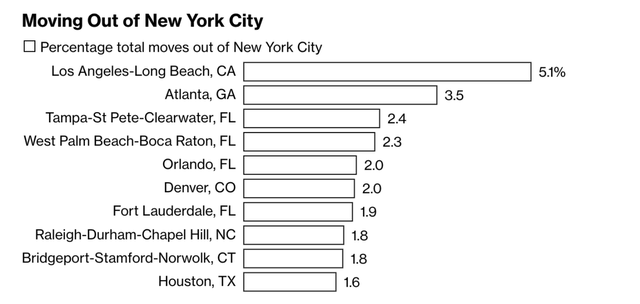
(Source: Bloomberg)
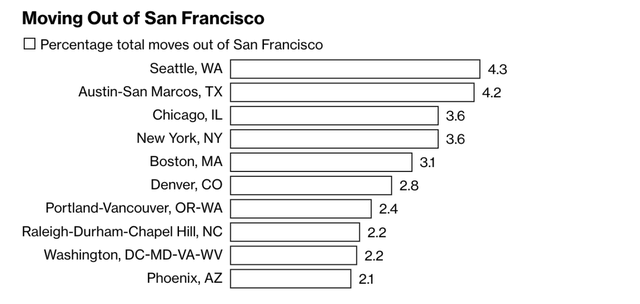
(Source: Bloomberg)
Thirdly, headwinds from more affordable homeownership should not hurt apartment REITs indefinitely. Interest rates are already at an all-time low – interest rates will likely be raised in the future (c. 2023 according to the Fed). Zoning restrictions by state governments also prevent the overbuilding and oversupply of homes in coastal regions. Furthermore, the cost of renting is still drastically lower than the cost of homeownership in these major cities. This is why apartment REITs are set up for success in these cities – they are able to house more individuals than single-family homes while offering affordability for individuals.
Finally, major coastal cities are incredibly resilient and have durable moats and high intrinsic value compared to other cities. San Francisco will continue to be the hub for technology innovation. Los Angeles will continue to dominate the film industry. New York will continue to be the epicenter of all things financial. The best universities will attract students to these cities. The culture is vibrant and tourism will recover in these cities. These are unique elements that have contributed to the success and appeal of these megacities for centuries, and they will continue to do so. These are characteristics that make these megacities iconic. In addition, these cities have stood the test of time from the September 11 attacks to earthquakes and wildfires, and I believe they will continue to do so.
For these reasons, bulls can argue that virus-related trends are temporary and that urban apartment REITs’ value and growth will bounce back.
Coastal Apartment REITs to Consider
Due to the reasons mentioned earlier, I believe the headlines of an urban exodus paint a gloomier picture than the data suggests. I believe coastal megacities will recover and continue their long track record of success. At the same time, coastal apartment REITs will capitalize on the gains as well. However, not all coastal apartment REITs will flourish after the pandemic ends. According to an NREI survey, industry participants believe that class-A properties have the best outlook. During these challenging times, it is important to focus on high-quality REITs with strong balance sheets. Based on these criteria, three blue-chip luxury coastal REITs come in mind: AvalonBay Communities (AVB), Essex Property Trust (ESS), and Equity Residential.
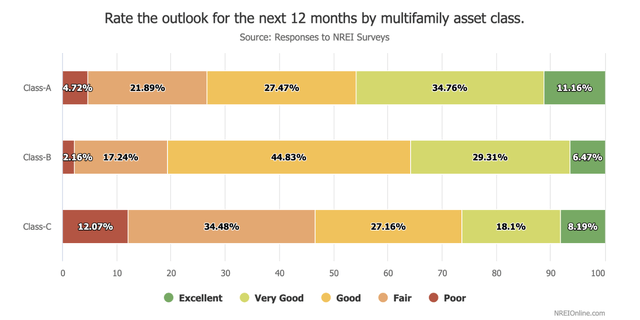
(Source: NREI)
Starting with the most conservative, AVB has a diversified portfolio of high-quality apartments primarily in New England, New York, New Jersey, Maryland, and California. As of Q2, AVB operates 295 apartment communities containing 86,380 apartment homes, with roughly 66% and 34% of the portfolio in suburban and urban areas, respectively. About half of apartment homes are also garden-style apartment homes, which are more spacious and are less densely packed than mid-rise and high-rise buildings. This can be a plus for renters looking for homes with extra space. Additionally, AVB has an A-rated balance sheet that is much stronger than it was during the Great Financial Crisis in 2008.

(Source: AVB 2019 Annual Report)
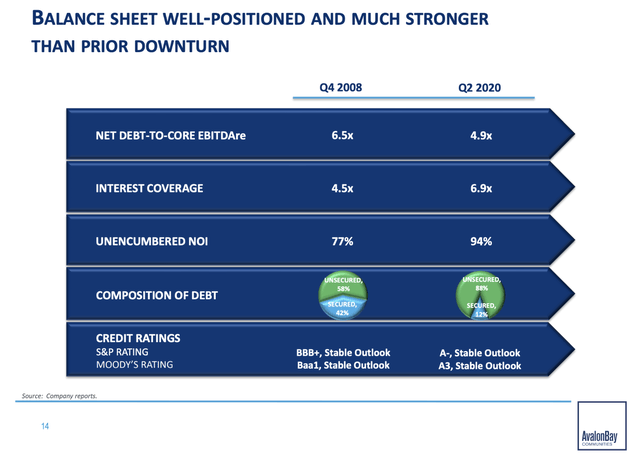
(Source: AVB Second Quarter 2020 Investor Teleconference Presentation)
Next in the list of high-quality coastal apartment REITs is EQR, which owns and operates 304 properties consisting of 78,410 apartment units, located in Boston, New York, Washington, D.C., Seattle, San Francisco, Southern California, and Denver. The downside with EQR is its higher-than-peers’ urban footprint. According to CEO Mark Parrell, EQR’s current portfolio mix stands at about 55% urban and 45% suburban. Furthermore, 69% of NOI is derived from mid/highrise buildings, while 31% of NOI comes from garden-style properties. The value proposition from highrise buildings in urban cities may be a less attractive option for renters during this pandemic. Lastly, EQR has a weaker balance sheet than ESS and AVB. However, EQR still has an A-rated balance sheet and a diversified high-quality portfolio of properties to protect it from virus-related headwinds.
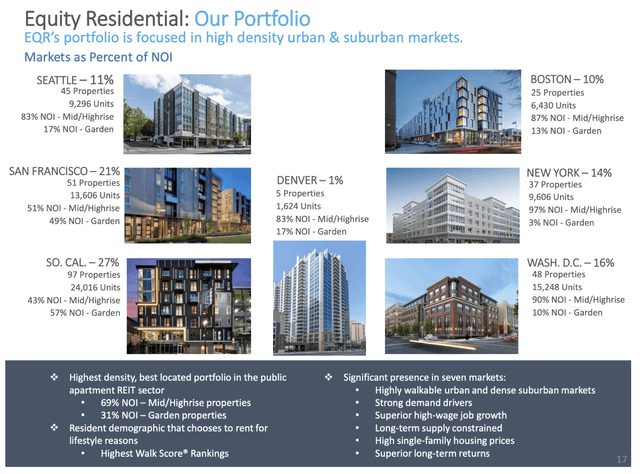
(Source: EQR March 2020 Investor Update)
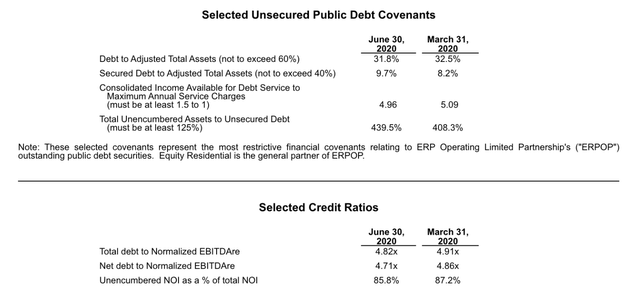
(Source: EQR Second Quarter 2020 Earnings Release)
Finally, and the riskiest of the three, we have ESS, which operates 247 properties consisting of 60,000 apartment homes concentrated in the west coast region. ESS is the riskiest due to the fact that the company is the least diversified, and thus, more prone to region-specific risks. However, ESS has a large portion of its portfolio located in suburban areas. According to COO John Burkart, the portfolio mix is 10% urban and 90% suburban, a big plus for the company given that suburban properties have become increasingly attractive during the pandemic. In addition, ESS has a strong balance sheet that will help the company deal with near-term challenges.
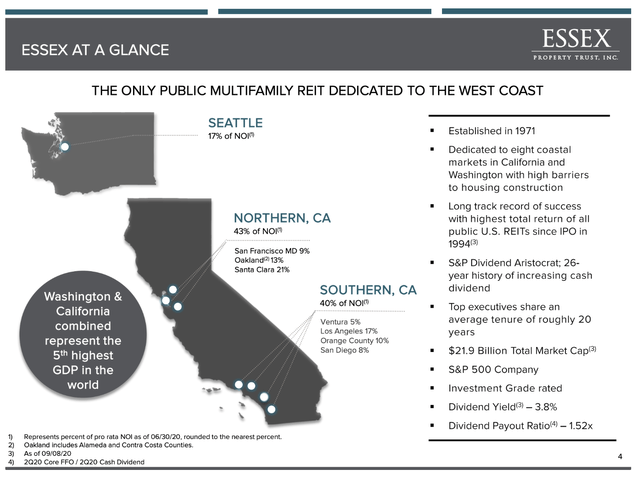
(Source: ESS September 2020 Investor Presentation)
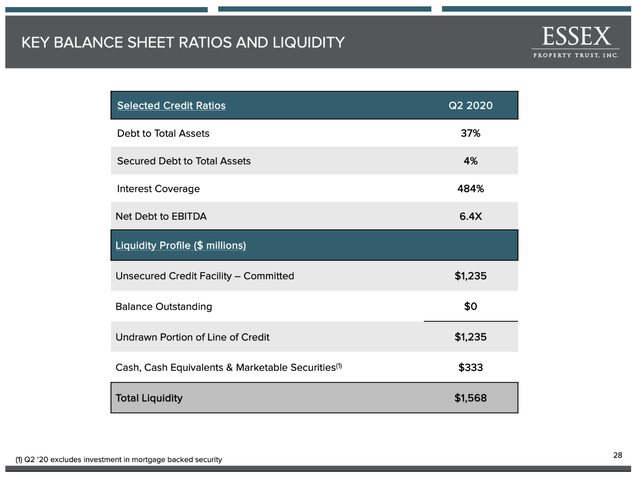
(Source: ESS September 2020 Investor Presentation)
Below shows a summary of the three companies’ performance for the last three quarters. As you can see, ESS suffered the highest drops in same-store revenue, net operating income, and occupancy rate. This is due to ESS being the least diversified and having a larger chunk of its portfolio concentrated in California, one of the worst-hit states during the pandemic. Ironically, I am most bullish on ESS given the growth in tech companies in the area and other reasons discussed earlier. Nonetheless, occupancy rates remain above 94%, an indication of resiliency and persistent demand in the coastal markets.
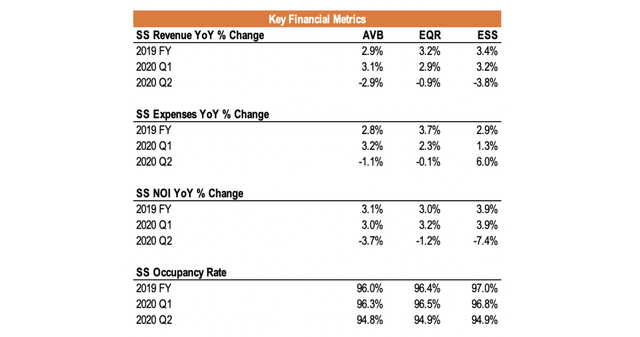
(Source: Company Earnings Releases and Author’s Analysis)
Risks and Opportunities
Besides the potential of a mass exodus, there are other risks pertaining to coastal apartment REITs. Some of the reasons include further delays in vaccine developments and a new stimulus bill. The new eviction moratorium has also banned landlords from throwing non-paying tenants; an extension of the ban beyond the end of the year will negatively impact landlords. Landlords may also have to incur extra maintenance costs and capital expenditures to keep facilities and amenities virus-proof. Low interest rates for longer periods of time, coupled with more supply of homes may further reduce the cost of homeownership relative to renting. Finally, the sectors such as travel, tourism, and food may never return to pre-pandemic levels – coastal regions are services-saturated. All these forces may cause rental demand to plunge, forcing landlords to add even more concessions than they already have.
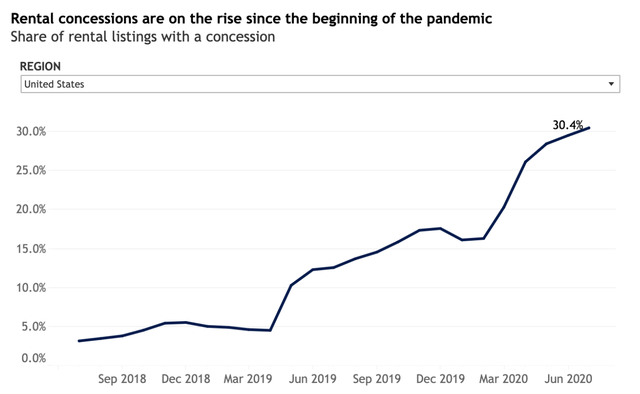
(Source: Zillow)
While it seems that it’s all doom and gloom for apartment REITs, there are opportunities for recovery and growth. Homes are essential for people and therefore, it remains a priority for people to continue to pay rent. Upgrades in amenities and facilities, such as larger, cozier lobbies and offices may also increase the attractiveness of renting. Apartment REITs with a large suburban exposure may be able to capture market share as it offers a good alternative for working individuals instead of moving out of state entirely. In addition, there are zoning restrictions and housing supply constraints in urban areas, which makes homeownership more limited and more expensive than renting. And finally, the coming wave of Millennials and post-Millennials will contribute favorably to the multifamily sector.
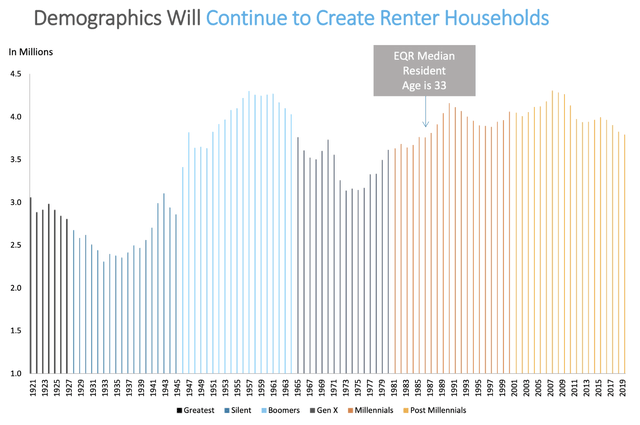
(Source: EQR March 2020 Investor Update)
Conclusion
As of this writing, AVB, EQR, and ESS remained more than 20% down year-to-date. Coastal apartment REITs lag behind while Sunbelt peers such as Camden Property (CPT) and Mid-America Apartments (MAA) sustained less of a blow. The divergence in returns between the two regions reflects the fears of an urban exodus. While there are signs of people moving out of urban cities, there has not been much data to support the thesis of a massive urban exodus. I believe the demand to live and work in coastal megacities will eventually recover and prosper once the pandemic situation is brought under control. As a result, I am very bullish on coastal apartment REITs.
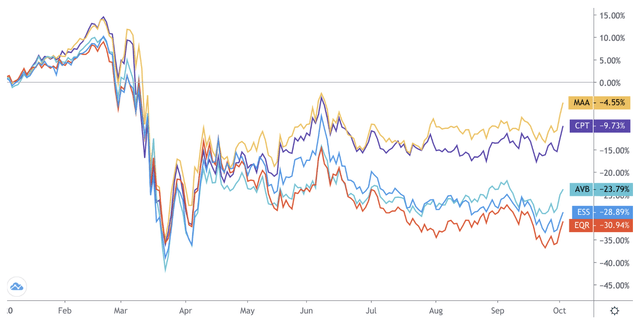
(Source: TradingView)
Here is a paragraph from a Curbed article:
Given that the media industry is concentrated in Manhattan – with another good chunk in San Francisco – journalists seem to be confusing the minor outbound migration from two ridiculously expensive areas with the double dose of demand happening across the country.
Don’t be fooled by the headlines. The theory of an urban exodus is overblown – buy coastal apartment REITs.
If you enjoyed this article, please like the article, leave a comment, and follow me for more in-depth company analysis.
Disclosure: I am/we are long ESS, EQR. I wrote this article myself, and it expresses my own opinions. I am not receiving compensation for it (other than from Seeking Alpha). I have no business relationship with any company whose stock is mentioned in this article.






